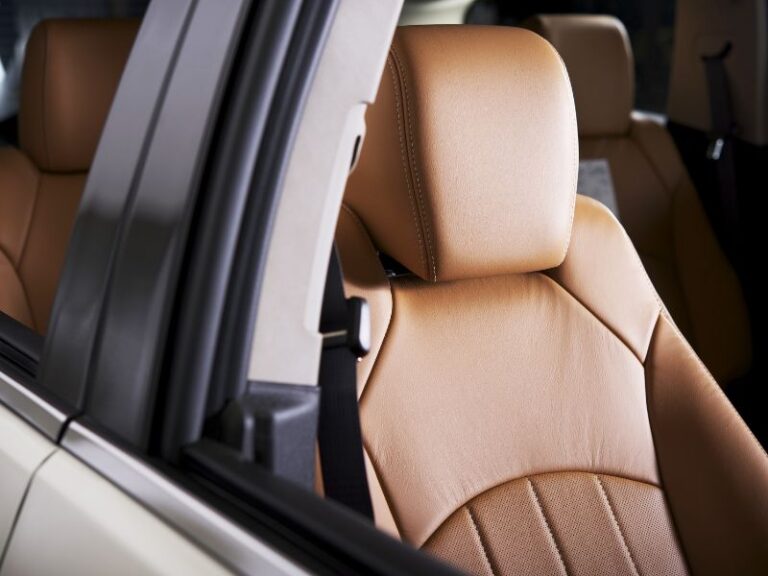What Car Seat Should a 6 Year Old Be In?
Many parents underestimate the importance of properly fitting a car seat for a 6-year-old, thinking any booster will suffice. However, the right choice can greatly impact your child's safety during a crash. While shifting from a car seat to a booster seat might seem straightforward, various options and guidelines can complicate the decision. Understanding what features to look for and how to guarantee a proper fit can make all the difference. Curious about which specific types of boosters provide the best support and safety?
Key Takeaways
- A 6-year-old typically transitions to a booster seat for proper seat belt fit and safety.
- Choose a high-back booster for added head and neck support, especially in vehicles without headrests.
- Ensure the booster seat meets the child's weight (usually 40-100 pounds) and height requirements (minimum of 4 feet 9 inches).
- Confirm the lap belt rests on the upper thighs and the shoulder belt crosses the shoulder correctly for optimal safety.
- Always follow manufacturer guidelines and local laws regarding car seat regulations and recommendations.
Understanding Car Seat Types
When choosing a car seat for your 6-year-old, it's crucial to understand the different types available. Car seat classifications help you determine which option best suits your child's needs.
At this age, most kids move on to booster seats, which elevate them to guarantee proper seat belt fit.
There are two main booster seat types: high-back and backless. High-back boosters offer head and neck support, making them ideal for vehicles without headrests. If your car has adequate head support, a backless booster might be sufficient.
Both types help position the seat belt correctly across your child's shoulder and lap, enhancing safety during travel.
It's also important to take into account your child's size and weight when selecting a booster seat. Check the manufacturer's guidelines to confirm you're choosing a seat that accommodates your child's growth.
Once you've selected the right seat, make sure to install it correctly for maximum safety.
Understanding these classifications and types will help you make an informed decision that keeps your child secure on the road.
Safety Guidelines for 6-Year-Olds
Ensuring your 6-year-old's safety in the car involves following specific guidelines that promote proper use of booster seats and seat belts. It's crucial to pay attention to height requirements and weight limits to keep your child safe.
Here's a quick reference table to help you understand the requirements:
| Requirement | Details |
|---|---|
| Height Requirement | At least 4 feet 9 inches |
| Weight Limit | Typically 40-100 pounds |
| Seat Type | Booster seat until height limit is met |
| Seat Belt Use | Must fit properly across shoulder and lap |
Once your child meets these height and weight benchmarks, they can shift to using a seat belt alone. However, make sure the seat belt fits correctly. The lap belt should lie snugly across the upper thighs, and the shoulder belt should rest across the shoulder, not the neck.
Transitioning From Car Seats
Changing from a car seat to a booster seat is an important step in your child's development, and it can feel intimidating. However, understanding car seat regulations can ease this change. Typically, kids can move to a booster seat around age 6, but always consider their weight and height. Your child's safety is paramount, so make certain they meet the manufacturer's requirements for the booster.
It's essential to remember that a booster seat positions the seat belt correctly over your child's body. It helps guarantee the lap belt lies low across their thighs and the shoulder belt fits snugly across their shoulder, maximizing child safety.
As you make this shift, check your local laws regarding car seat regulations, as they can vary widely.
Before changing, discuss it with your child. Explain why it's important and how they'll be safer in a booster seat. You might even let them help pick out their new seat, making it a fun experience.
Ultimately, staying informed and proactive about your child's car seat needs will assure they're safe and secure on every ride.
Recommended Car Seats and Boosters
When it comes to choosing the right booster seat for your 6-year-old, you'll find several options that prioritize safety and comfort.
From high-back boosters to backless models, understanding the types available can help you make a better decision.
Don't forget to take into account essential safety features, as they play a vital role in keeping your child secure while on the road.
Types of Booster Seats
Finding the right booster seat for your six-year-old is vital for their safety and comfort while traveling. There are two main types of booster seats to take into account: high back boosters and backless boosters.
High back boosters provide additional head and neck support, which can be particularly beneficial for younger kids who may still need that extra security. They also help position the seatbelt properly across your child's body, guaranteeing a safer fit.
If your vehicle has low seat backs or lacks headrests, a high back booster is a smart choice.
On the other hand, backless boosters are typically more portable and lightweight, making them easier to move between vehicles. They're a great option if your child has outgrown a traditional car seat but still needs a boost to guarantee the seatbelt fits correctly.
Backless boosters work best in cars with adequate headrests and seat backs.
Ultimately, the choice between a high back and backless booster depends on your child's size, comfort, and your vehicle's specifications.
Always remember to follow the manufacturer's guidelines and local laws when selecting the best option for your child.
Safety Features to Consider
Safety is paramount when choosing a booster seat for your six-year-old, and there are several essential features to take into account. First, look for booster seats with robust harness systems. These systems provide an extra layer of protection, ensuring that your child is securely restrained during travel. Furthermore, consider seats designed with side impact protection. This feature helps absorb crash forces and can greatly reduce the risk of injury.
To help you decide, here's a quick comparison of popular booster seats:
| Feature | Booster Seat A |
|---|---|
| Harness System | 5-point harness |
| Side Impact Protection | Yes |
| Weight Limit | Up to 100 lbs |
| Feature | Booster Seat B |
| Harness System | Adjustable 3-point |
| Side Impact Protection | Yes |
| Weight Limit | Up to 120 lbs |
| Feature | Booster Seat C |
| Harness System | Built-in 5-point |
| Side Impact Protection | Yes |
| Weight Limit | Up to 110 lbs |
Transitioning From Car Seats
As your child reaches six years old, it's time to think about shifting from a traditional car seat to a booster seat. This change is an important age milestone in your child's development and safety. Booster seats raise your child so that the vehicle's seatbelt fits properly, guaranteeing maximum protection during rides.
When considering shifting strategies, look for booster seats that are easy to install and offer side-impact protection. High-back boosters provide head and neck support, which is beneficial for younger children, while backless boosters may be suitable for older or taller kids.
Always check the manufacturer's guidelines to confirm the booster seat is appropriate for your child's weight and height.
It's vital to keep your child in a booster seat until they're tall enough—generally around 4 feet 9 inches—to use the vehicle's seatbelt alone. Remember, the goal is to keep them safe and secure in the car, so taking this step seriously is important.
As you navigate this change, keep in mind that your child's comfort and safety should always come first.
Installation Tips for Parents
While installing a car seat for your 6-year-old may seem straightforward, there are important steps to guarantee it's done correctly.
First, choose the right seat belt installation techniques that suit your vehicle and the car seat model. Always refer to the manufacturer's instructions for both the car seat and your vehicle.
Ensure the car seat is secured tightly. You can check this by grabbing the seat at the base and attempting to move it side to side. There should be minimal movement—no more than an inch. If there's too much wiggle, try re-tightening the seat belt or using the LATCH system if available.
When using a seat belt, make sure it lies flat and isn't twisted. The shoulder belt should cross your child's shoulder and chest, away from the neck, while the lap belt should fit snugly across their hips.
Finally, always buckle your child securely in the seat. A properly installed car seat not only keeps your child safe but also allows you to drive with peace of mind.
Double-check all aspects before hitting the road, and don't hesitate to reach out for help if you're unsure.
Common Mistakes to Avoid
When installing a car seat for your 6-year-old, it's easy to overlook essential details that can compromise safety.
Avoiding common mistakes is vital for guaranteeing your child's protection. Here are four mistakes to steer clear of:
- Incorrect Height: Make sure the car seat matches your child's height requirements. Using a seat that's too small can lead to inadequate protection.
- Improper Usage: Always follow the manufacturer's instructions for installation. Misunderstanding how to secure the seat can result in a dangerous ride.
- Ignoring Weight Limits: Double-check that your child hasn't outgrown the seat's weight limit. This oversight can greatly decrease safety in a crash.
- Neglecting to Adjust Harness Straps: Confirm the harness is snug and at the correct height. Loose straps can lead to improper usage, compromising your child's safety.
Frequently Asked Questions
Can My Child Use a Regular Seatbelt Without a Booster?
You can let your child use a regular seatbelt without a booster if they meet height and weight requirements. Always check booster seat laws in your area to guarantee your child's seatbelt safety.
What Is the Weight Limit for Booster Seats?
When it comes to booster seat safety, you'll want to follow the weight limit guidelines. Typically, most booster seats accommodate children weighing between 40 to 100 pounds, but always check your specific seat's instructions for accuracy.
How Do I Choose the Right Booster Seat for My Child?
To choose the right booster seat for your child, consider booster seat types like high-back or backless. Check safety features such as side-impact protection and seatbelt guides to guarantee maximum security during travel.
Are There Specific Laws for Car Seats in Different States?
Yes, there are specific laws regarding car seats in different states. You'll need to check state regulations, as they vary based on your child's age, weight, and height to guarantee you're compliant and safe.
What Should I Do if My Child Refuses to Use a Booster Seat?
If your child resists using a booster seat, prioritize their safety. Explain the importance of seat resistance for child safety. Offer incentives, make it fun, or involve them in choosing the seat to encourage compliance.
Conclusion
In summary, ensuring your 6-year-old is safely secured in a booster seat is essential for their protection on the road. Did you know that using the right car seat can reduce the risk of injury by 45%? As they grow, moving to the appropriate booster helps guarantee a proper seat belt fit, keeping them safe in the event of an accident. Prioritizing safety now can make all the difference, so stay informed and vigilant about your child's car seat needs.
- Can I Get in a Taxi Without a Car Seat? - January 26, 2025
- Can I Get Chlamydia From a Toilet Seat? - January 26, 2025
- Can I Get an Uber With a Car Seat? - January 26, 2025






